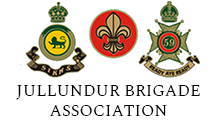- Honour for Commemorator of Sikh WW1 ContributionSikh people have been coming to Ieper for decades in the build-up to Armistice Day on 11 November. The Sikhs, with their beards and turbans as typical features, made an important contribution to the Great War, taking part in the Westhoek fights... […]
- The Links Between the 34th Sikh Pioneers and the 8th Jullundur BrigadeThe United Kingdom and the British Empire declared war on Germany on 4th August 1914. Orders to mobilize were given in India on 8th August to the 3rd Lahore and 7th Meerut Divisions, key elements of the Northern Army in India... […]
- The service of Sepoy Ajab Khan 59th Scinde Rifles (Frontier Force)JBA Member Charles Sandbach found that it was not an easy task researching Ajab as no documents exist that chart his life. Known facts how are that he came from the tribal Banni area of Punjab, north of Mianwali which at that time was part of India but is now a part of Pakistan... […]
- Sergeant Jim Maguire’s SurvivalThe following letter was published in the Sunday Times of 30th January 2011:"The Extraordinary Tale of a Battlefield SurvivorYour article on the American congresswoman who survived a gunshot wound to the head ("Giffords saved by surgery learnt on the battlefield", World News last week) reminded me of my maternal grandfather Jim Maguire's experiences in 1916 during the first world war. […]
- Major General Sir Philip Mainwaring Carnegy KCBMajor General Sir Philip Carnegy was in command of the Jullundur Brigade in India when it was ordered to France in 1914. He took it there and retained command until being succeeded by Brigadier Peter Strickland in 1915 who, at that time, was commanding Ist Manchesters within the Brigade. A short account of his life and service follows. […]
- The 34th Royal Sikh PioneersThe Pioneer regiments of the Indian Army were specialised infantry rather than engineers. Regarded as amongst the elite of the Indian Army, the Pioneers were trained first and foremost as infantry but they were additionally skilled in road and railway building and their abilities were prized in the theatre of the North West Frontier. Indeed they were described as “a superior kind of infantry, as expert with the rifle as with pick and shovel” and rarely if ever did a Frontier expedition set out without a Pioneer regiment. […]
- Acting Corporal Issy Smith VCThe sixteen year old Issy Smith enlisted in the Manchester Regiment on 2 September 1904 and as a boy soldier joined the Regiment at the regimental depot in Ashton-under-Lyne, Lancashire. Following service with the 2nd Manchesters in Aldershot and 3rd Manchesters in South Africa he joined the 1st Battalion at Secunderabad in India in October 1906. During his time there he became the battalion middleweight boxing champion and played soccer for the battalion. […]
- A Monument to the Punjab Frontier Force in LondonA remarkable monument to one of the most famous formations of the old Indian Army stands almost forgotten just a few hundred yards from the cacophony of the King’s Road in Chelsea. St. Luke’s Church is home to the memorial chapel of the Punjab Frontier Force (PFF), a repository of the memories and traditions of a force that carved out an epic reputation on the North West Frontier. […]
- Lieutenant General (Edward) Peter Strickland KBE CB DSOLieutenant General Strickland commanded the Jullundur Brigade in France, in the rank of Brigadier General, throughout most of 1915... […]
- The ChattriThe Chattri on the South Downs outside Brighton is an unique Memorial which stands in memory of all Indian soldiers who died during the First World war but it is particularly associated with 53 Hindu and Sikh soldiers, including from the Jullundur Brigade, who died in hospitals in Brighton during 1914-15 and whose remains were cremated on the spot. Twenty one Muslims who died in Brighton were buried in the Shah Jehan Mosque in Woking. […]
Articles
Copyright © 2024
